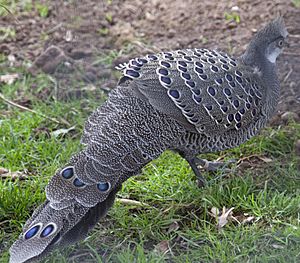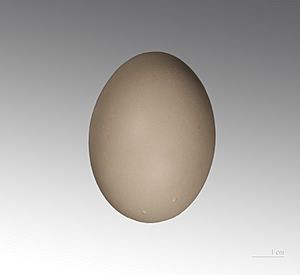Grey peacock-pheasant facts for kids
Quick facts for kids Grey peacock-pheasant |
|
|---|---|
 |
|
| At Birmingham Nature Centre, England | |
| Conservation status | |
| Scientific classification | |
| Kingdom: | |
| Phylum: | |
| Class: | |
| Order: | |
| Family: | |
| Subfamily: |
Argusianinae
|
| Genus: |
Polyplectron
|
| Binomial name | |
| Polyplectron bicalcaratum |
|
The Grey Peacock-Pheasant (Polyplectron bicalcaratum) is a large, beautiful bird. It is also known as the Burmese Peacock-Pheasant. This bird is a type of pheasant and lives in Asia. It is very special because it is the national bird of Myanmar.
Contents
What Does It Look Like?
This pheasant is quite big, growing up to 76 centimeters (about 30 inches) long. It has a greyish-brown body. You might notice its feathers have many small, green, shiny spots. These spots look like tiny eyes, which is why they are called eyespots.
The Grey Peacock-Pheasant also has a long, bushy crest on its head. Its face has bare skin that can be pink or yellow. It has a white throat and grey eyes. Its beak and legs are also grey.
Males and females look quite similar. However, the female is usually a bit smaller. She also has darker feathers and fewer fancy decorations than the male. Young pheasants look a lot like the female birds.
Where Does It Live and What Does It Eat?
The Grey Peacock-Pheasant lives in forests. You can find it in lowlands and hills. Its home stretches across Bangladesh, Northeast India, and parts of Southeast Asia. This includes countries like Laos, Myanmar, Thailand, and Vietnam. However, it does not live in most of Indochina or the entire Malay Peninsula.
This bird's diet is mostly made up of seeds. But it also enjoys eating other things. It looks for termites, fruits, and small creatures without backbones. These small creatures are called invertebrates.
Life Cycle and Reproduction
When it's time to lay eggs, the female Grey Peacock-Pheasant usually lays two eggs. These eggs will hatch into young pheasants.
Is It Safe? (Conservation Status)
The Grey Peacock-Pheasant lives across a very large area. Because of this, many of these birds exist in the wild. Experts have checked on its numbers. They have decided it is a species of Least Concern. This means it is not currently in danger of disappearing.
This status is given by the IUCN Red List of Threatened Species. The IUCN Red List is a list that tells us how safe different animals and plants are in the world. It helps people know which species need help to survive.
See also
 In Spanish: Espolonero chinquis para niños
In Spanish: Espolonero chinquis para niños



